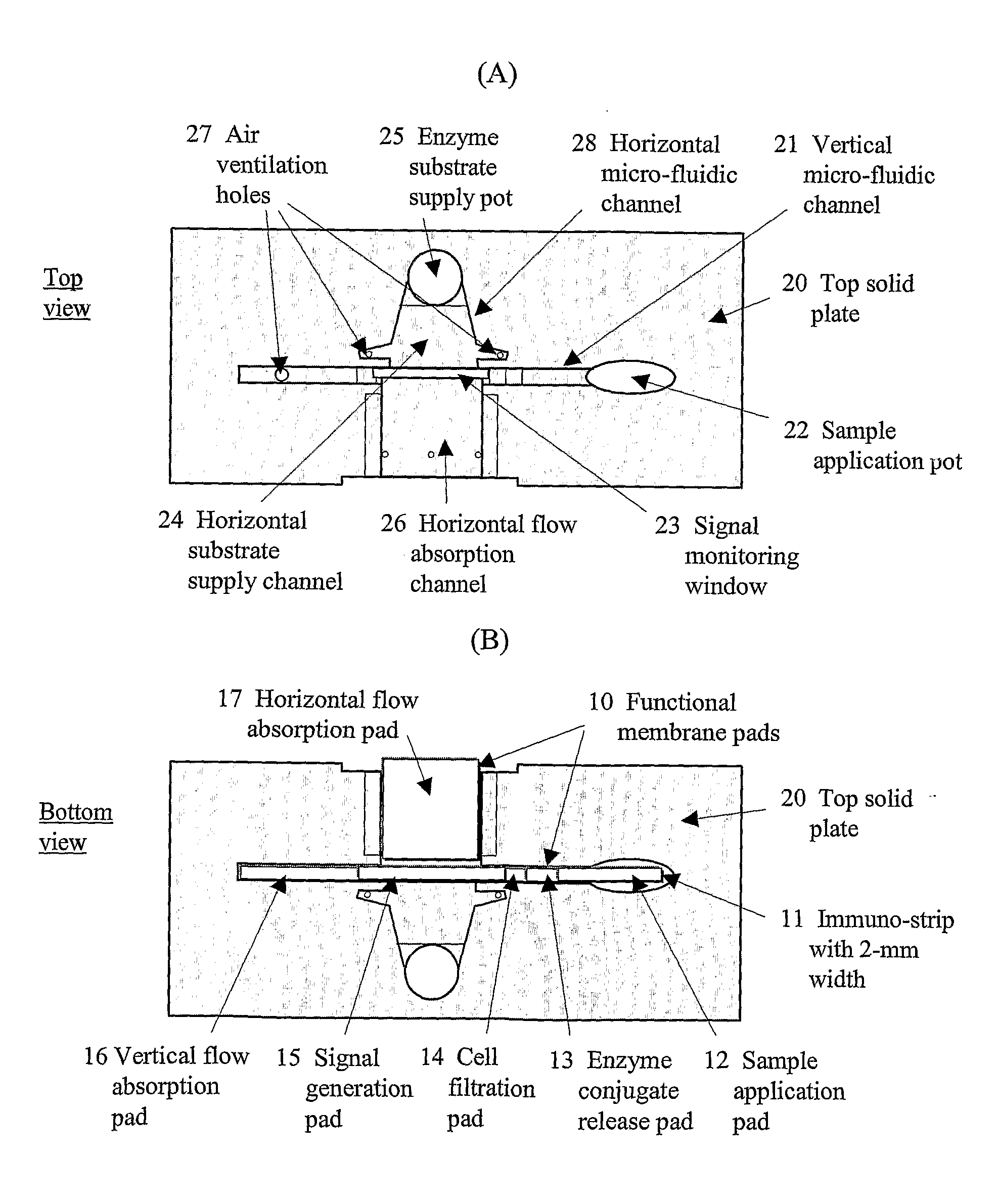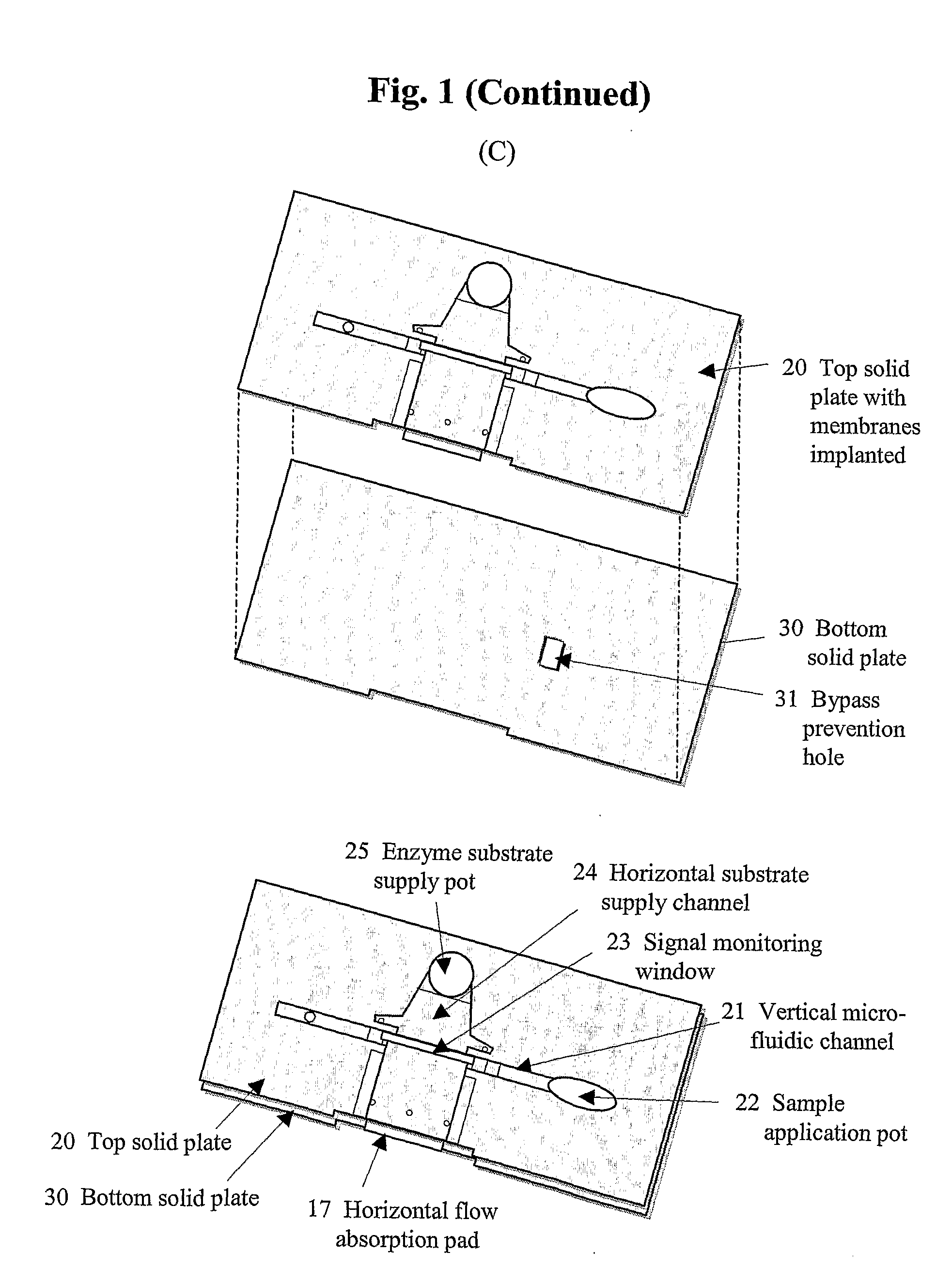Lab-On-A-Chip For An On-The-Spot Analysis And Signal Detection Methods For The Same
a biosensor and signal detection technology, applied in the field of labonachip version of biosensors, can solve the problems of low reproducibility of analysis, inability to hold the samples in a precise arrangement, and frequent application of severe pain, and achieve the effect of reducing costs
- Summary
- Abstract
- Description
- Claims
- Application Information
AI Technical Summary
Benefits of technology
Problems solved by technology
Method used
Image
Examples
example 1
Synthesis of HRP-Labeled Antibody
1-1. Production of Monoclonal Antibody
[0079] A monoclonal antibody specific to cTnI was raised through the adoption of a standard protocol. cTnI (30 g) was emulsified with Complete Freund's adjuvant and injected into the peritoneal cavity of a 6-week old Balb / c mouse. After 3 weeks, the mouse was immunized with the same amount of cTnI emulsified with Incomplete Freund's adjuvant. An identical procedure was repeated 2 weeks later, and the final immunization was conducted after the same period with cTnI dissolved in 10 mM phosphate buffer, pH 7.4, (PB) containing 140 mM NaCl (PBS). Three days after the final boosting, the mouse splenocytes were collected and fused with murine plasmacytoma (sp2 / 0 Ag 14) as a fusion partner. Fused hybridoma cells were screened based on HAT selection, and a cell clone producing antibody specific to cTnI (BD Clone 12) was finally screened by immunoassay using antigen-coated microtiter plates. This antibody was produced ...
example 2
Construction of Lab-on-a-Chip
2-1. Preparation of Immuno-Strip
[0081] To accomplish the immuno-chromatographic assay for cTnI in the vertical direction, four different functional membrane pads have been employed (refer to FIG. 1B). Each sample application pad was a glass fiber membrane (2×15 mm; Ahlstrom 8980) pre-treated with polyvinyl alcohol by the manufacturer. A conjugate release pad was fabricated by transferring 8 L of a conjugate solution onto a glass membrane (2×5 mm; Rapid 24Q). The conjugate solution was prepared by diluting the HRP labeled-antibody (2.5 g / mL) with 100 mM PB containing 0.5% casein (Casein-PB), HAMA blocker (150 g / mL), ascorbic acid (5 mM), Triton X-100 (0.5%, v / v), and trehalose (20%, w / v). A signal generation pad was made by dispensing (1.5 L / cm) the monoclonal antibody (Clone 19C7; 2 mg / mL) in PBS onto a site at 10 mm from the bottom of NC membrane (2×25 mm) using a microdispenser (BioJet 3000, Biodot, Irvine, Calif.). On the same membrane, goat anti-m...
example 3
Characterization of Analytical Performances
3-1. Preparation of Standard Samples of cTnI
[0085] A stock of cTnI (1 mg / mL; I-T-C complex form) was serially diluted with human serum to prepare samples at pre-determined concentrations. The serum itself was regarded as the negative sample.
3-2. Calibration
[0086] Under optimal conditions, the responses of the lab-on-a-chip to the analyte concentrations were obtained using the standard samples of cTnI. The samples were added into different lab-on-a-chip, the immune reactions were processed for 15 min and, sequentially, the signal generation was processed for 5 min after the enzyme substrate was supplied. The chip with colored signals as shown in FIG. 2 was placed under a digital camera (FA185A#ABA, Hewlett-Packard, Palo Alto, Calif.) built within a detector and illuminated from the bottom using a light source (SR0307A-5230, Seho Robot, South Korea) as shown in FIG. 3. The image of the signal generation pad was captured and the color de...
PUM
| Property | Measurement | Unit |
|---|---|---|
| width | aaaaa | aaaaa |
| volume | aaaaa | aaaaa |
| widths | aaaaa | aaaaa |
Abstract
Description
Claims
Application Information
 Login to View More
Login to View More - R&D
- Intellectual Property
- Life Sciences
- Materials
- Tech Scout
- Unparalleled Data Quality
- Higher Quality Content
- 60% Fewer Hallucinations
Browse by: Latest US Patents, China's latest patents, Technical Efficacy Thesaurus, Application Domain, Technology Topic, Popular Technical Reports.
© 2025 PatSnap. All rights reserved.Legal|Privacy policy|Modern Slavery Act Transparency Statement|Sitemap|About US| Contact US: help@patsnap.com



